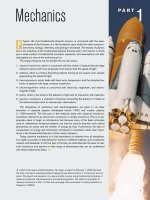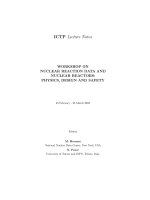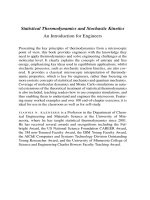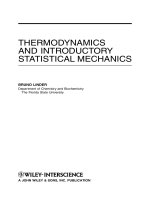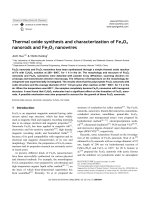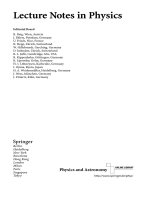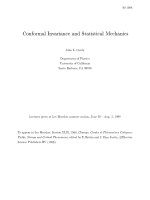- Trang chủ >>
- Khoa Học Tự Nhiên >>
- Vật lý
Robert floyd sekerka thermal physics thermodynamics and statistical mechanics for scientists and engineers
Bạn đang xem bản rút gọn của tài liệu. Xem và tải ngay bản đầy đủ của tài liệu tại đây (7.57 MB, 610 trang )
Thermal Physics
Thermal Physics
Thermodynamics and Statistical Mechanics
for Scientists and Engineers
Robert F. Sekerka
Carnegie Mellon University
Pittsburgh, PA 15213, USA
AMSTERDAM • BOSTON • HEIDELBERG • LONDON • NEW YORK • OXFORD
PARIS • SAN DIEGO • SAN FRANCISCO • SINGAPORE • SYDNEY • TOKYO
Elsevier
Radarweg 29, PO Box 211, 1000 AE Amsterdam, Netherlands
The Boulevard, Langford Lane, Kidlington, Oxford OX5 1GB, UK
225 Wyman Street, Waltham, MA 02451, USA
Copyright © 2015 Elsevier Inc. All rights reserved.
No part of this publication may be reproduced or transmitted in any form or by any means, electronic or
mechanical, including photocopying, recording, or any information storage and retrieval system, without
permission in writing from the publisher. Details on how to seek permission, further information about the
Publisher’s permissions policies and our arrangements with organizations such as the Copyright Clearance
Center and the Copyright Licensing Agency, can be found at our website: www.elsevier.com/permissions.
This book and the individual contributions contained in it are protected under copyright by the Publisher (other
than as may be noted herein).
Notices
Knowledge and best practice in this field are constantly changing. As new research and experience broaden our
understanding, changes in research methods, professional practices, or medical treatment may become
necessary.
Practitioners and researchers must always rely on their own experience and knowledge in evaluating and using
any information, methods, compounds, or experiments described herein. In using such information or methods
they should be mindful of their own safety and the safety of others, including parties for whom they have a
professional responsibility.
To the fullest extent of the law, neither the Publisher nor the authors, contributors, or editors, assume any
liability for any injury and/or damage to persons or property as a matter of products liability, negligence or
otherwise, or from any use or operation of any methods, products, instructions, or ideas contained in the
material herein.
Library of Congress Cataloging-in-Publication Data
A catalog record for this book is available from the Library of Congress
British Library Cataloguing in Publication Data
A catalogue record for this book is available from the British Library
For information on all Elsevier publications
visit our website at />ISBN: 978-0-12-803304-3
Dedication
To Care . . . .
who cared about every word
and helped me write what I meant to say
rather than what I had written
v
•••
•••
•••
Tableof Contents
About the Cover
Preface
PART I
1
2
3
xv
XVII
Thermodynamic s
1
Intr oduct ion
3
1.1
Temper ature
3
1.2
Thermodynamics Versus Statistical Mechanics
5
1.3
Classification of State Variabl es
6
1.4
Energy in Mechanics
8
1.5
Elementary Kinetic Theory
12
First Law of Thermodynamics
15
2.1
Statement of the First Law
15
2.2
Quasistatic Work
17
2.3
Heat Capacities
19
2.4
Work Due to Expansion of an Ideal Gas
24
2.5
Enthalpy
28
Second Law of Thermod ynamics
31
3.1
Statement of the Second Law
32
3.2
Carnot Cycle and Engines
35
3.3
Calculation of th e Entropy Chang e
39
3.4
Combined First and Second Laws
41
3.5
Statistical Interpretation of Entrop y
47
vii
viii Table of Contents
4
5
6
7
8
Third Law of Thermodynamics
49
4.1
Statement of the Third Law
49
4.2
Implications of the Third Law
50
Open Systems
53
5.1
Single Component Open System
53
5.2
Mu lticomponent Open Systems
55
5.3
Euler Theorem of Homogeneous Functions
59
5.4
Chemical Potential of Real Gases, Fugacity
64
5.5
Legen dre Transformations
67
5.6
Partial Molar Quantities
71
5.7
Entropy of Chemical Reaction
75
Equilibrium and Thermodynamic Potentia ls
79
6.1
Entropy Criterion
79
6.2
Energy Criterion
84
6.3
Other Equilibrium Criteria
88
6.4
Summary of Criteria
92
Requirements for Stabi lity
95
7.1
Stability Requirements for Entrop y
95
7.2
Stability Requirements for Internal Energy
100
7.3
Stability Requirements for Other Potentials
102
7.4
Consequences of Stability Requiremen ts
105
7.5
Extension to Many Variables
106
7.6
Principles of Le Chatlier and Le Chatlier-Braun
107
Monocomponent
Phase Equi librium
8.1
Clausius-Clapeyron
8.2
Sketches of the Thermodynamic
8.3
Phas e Diagram in th e v, p Plane
109
110
Equation
Function s
115
118
Table of Contents
9
10
11
12
13
ix
Two -Phase Equilibrium for a van der Waa ls Fluid
121
9.1
van der Waals Equation of State
121
9.2
Thermodynamic Functions
124
9.3
Phase Equilibrium and Miscibility Gap
127
9.4
Gibbs Free Energy
131
Binary Solutions
137
10.1 Thermodynamics of Binary Solutions
137
10.2 Ideal Soluti ons
142
10.3 Phase Diagram for an Ideal Solid and an Ideal Liquid
145
10.4 Regular Solution
148
10.5 General Binary Solutions
153
Externa l Forces and Rotating Coordinate Systems
155
11.1 Conditions for Equilibrium
155
11.2 Uniform Gravitational Field
157
11.3 Non-Uniform Gravitational Field
164
11.4 Rotating Systems
164
11.5 Electric Fields
166
Chemica l Reactions
167
12.1 Reactions at Constant Volume or Pressure
168
12.2 Standard States
171
12.3 Equilibr ium and Affinity
173
12.4 Explicit Equilibrium Conditions
175
12.5 Simul taneous Reactions
182
Thermodynam ics of Fluid-Fluid Interf aces
185
13.1 Planar Interfaces in Fluids
186
13.2 Curved Interfaces in Flu ids
197
x Table of Contents
13.3 Interface Junctions and Contact Angles
202
13.4 Liquid Surface Shape in Gravity
205
14 Thermodynamics of Solid-Flu i d Interfaces
215
14.1 Planar Solid-Fluid Interfaces
216
14.2 Anisotropy of y
22 1
14.3 Curved Solid-Fluid Interfaces
227
14.4 Faceting of a Large Planar Face
233
14.5 Equilibrium Shape from the~ -Vector
236
14.6 Herring Formula
240
14.7 Legendre Transform of the Equilibrium Shape
241
14.8 Remarks About Solid-Solid Interfaces
242
PART II
Statistical Mechanics
15 Entropy and Information Theory
15.1 Entropy as a Measure of Disorder
15.2
Boltzmann Eta Theorem
16 Microcanonical Ensemble
245
247
247
251
257
16.1 Fundamenta l Hypothesis of Statistical Mechanics
258
16.2 Two-Stat e Subsystems
261
16.3 Harmonic Oscillators
265
16.4 Ideal Gas
267
16.5 Multicomponent
Ideal Gas
17 Classical Microcanonical Ensemble
273
277
17.1 Liouville's Theorem
278
17.2 Classical Microcanonical Ensemble
280
Tab le of Contents
18
Distinguishable Part icles with Negligible
Interaction Energies
18.1
Derivation of the Boltzmann Distribution
18.2 Two-State Subsystems
18.3
Harmonic Oscillators
18.4 Rigid Linear Rotator
19 Canonical Ensemble
19. 1 Three Derivations
19.2
21
285
285
289
293
303
305
305
312
19.3 Classica l Idea l Gas
313
19.4 Maxwell-Boltzmann Distribution
317
19.5 Energy Dispersion
320
19.6 Paramagnetism
321
19.7
20
Factorizat ion Theorem
xi
Partition Function and Densit y of States
330
Classical Canonical Ensemble
337
20.1
Classical Ideal Gas
338
20.2
Law of Dulong and Petit
342
20.3
Averaging Theorem and Equipartition
343
20.4
Virial Theorem
346
20.5
Virial Coefficients
348
20.6
Use of Canonical Transforma tions
354
20.7
Rotating Rigid Polya tomi c Molecu les
356
Grand Canonical Ensemble
359
21.1
Derivation from Microcanonical Ensemble
360
21.2
Ideal Systems: Orbitals and Factorization
368
xii Table of Contents
22
21.3 Classical Ideal Gas with Internal Structure
380
21.4 Multicomponent
388
21.5 Pressure Ensemb le
389
Entropy for Any Ensemb le
397
22.1 General Ensemble
397
22.2
23
405
406
23.2 The Functions hv(A, a)
408
23.3 Virial Expansio ns for Ideal Fermi and Bose Gases
410
23.4 Heat Capacity
412
Bose Condensat ion
413
Bosons at Low Temperatures
413
24.2 Thermodynamic Functions
416
Condensate Region
421
24.3
Degenerate Fermi Gas
425
25.1
Ideal Fermi Gas at Low Temperatures
425
25.2
Free Electron Model of a Metal
428
25.3 Thermal Activation of Electrons
429
25.4 Pauli Paramagnetism
433
25.5
Landau Diamagnetism
436
25.6 Thermionic Emission
439
Semiconductors
442
25.7
26
402
Integr al Formulae
24.l
25
Summation over Energy Levels
Un ified Treatment of Idea l Fermi, Bose, and Classical Gases
23.1
24
Systems
Quantum Statistics
451
26.1 Pure States
451
26.2
Statistical States
453
Table of Contents
26.3 Random Phases and External Influ ence
454
26.4 Time Evoluti on
455
26.5 Densit y Operators for Specific Ensembles
456
26.6 Examp les of th e Density Matrix
459
Indi stinguishable Particles
465
26.7
27
Ising Model
469
27.1
470
Ising Mod el, Mean Fie ld Treatment
27.2 Pair Sta tistics
477
27.3
479
Soluti on in One Dimension for Zero Field
27.4 Transfer Matrix
480
27.5 Oth er Methods of Soluti on
483
27.6 Monte Carlo Simulation
484
PARTIll
A
B
C
D
xiii
Appendices
495
Stirl ing 's Approximation
497
A.l
Elem entary Mot ivation ofEq. (A.l )
498
A.2
Asymptotic Series
499
Use of Jacobians to Convert Partial Derivatives
503
B.l
Properties of Jacobians
503
B.2
Connect ion to Thermody namic s
504
Differential Geometry of Surfaces
509
C.l
Alterna tive Formulae for ~ Vector
509
C.2
Sur face Differe nti al Geome try
511
C.3
~
516
C.4
Herring Form ula
Vector for Genera l Surfaces
Equi librium of Two-State Systems
518
523
xiv Table of Contents
E
F
G
H
Aspects of Canonical Transformations
529
E.1
Necessary and Sufficient Conditions
530
E.2
Restricted Canonical Transformations
534
Rotation of Rigid Bodies
537
El
Moment oflnertia
537
F.2
Angular Momentum
539
F.3
Kinetic Energy
540
F.4
Time Derivatives
540
F.5
Rotating Coordinate System
541
F.6
Matrix Formulation
544
F.7
Canonical Variables
546
F.8
Quantum Energy Levels for Diatomic Molecule
547
Thermodynamic Perturbation Theory
549
G.1
Classical Case
549
G.2
Quantum Case
550
Selected Mathematical Relations
553
H.1
Bernoulli Numbers and Polynomials
553
H.2
Euler-Maclaur in Sum Formula
554
Creation and Annihilation
559
1.1
Harmonic Oscillator
559
1.2
Boson Operators
560
1.3
Fermion Operators
562
1.4
Boson and Fermion Number Operators
563
References
Index
Operators
565
569
About the Cover
To represent the many scientists who have made major contributions to the foundations of
thermodynamics and statistical mechanics, the cover of this book depicts four significant
scientists along with some equations and graphs associated with each of them.
• James Clerk Maxwell (1831-1879) for his work on thermodynamics and especially the
kinetic theory of gases, including the Maxwell relations derived from perfect differentials and the Maxwell-Boltzmann Gaussian distribution of gas velocities, a precursor of
ensemble theory (see Sections 5.2, 19.4, and 20.1).
• Ludwig Boltzmann (1844-1906) for his statistical approach to mechanics of many
particle systems, including his Eta function that describes the decay to equilibrium
and his formula showing that the entropy of thermodynamics is proportional to the
logarithm of the number of microscopic realizations of a macrosystem (see Chapters
15–17).
• J. Willard Gibbs (1839-1903) for his systematic theoretical development of the thermodynamics of heterogeneous systems and their interfaces, including the definition
of chemical potentials and free energy that revolutionized physical chemistry, as well
as his development of the ensemble theory of statistical mechanics, including the
canonical and grand canonical ensembles. The contributions of Gibbs are ubiquitous
in this book, but see especially Chapters 5–8, 12–14, 17, 20, and 21.
• Max Planck (1858-1947, Nobel Prize 1918) for his quantum hypothesis of the energy of
cavity radiation (hohlraum blackbody radiation) that connected statistical mechanics
to what later became quantum mechanics (see Section 18.3.2); the Planck distribution
of radiation flux versus frequency for a temperature 2.725 K describes the cosmic
microwave background, first discovered in 1964 as a remnant of the Big Bang and later
measured by the COBE satellite launched by NASA in 1989.
The following is a partial list of many others who have also made major contributions
to the field, all deceased. Recipients of a Nobel Prize (first awarded in 1901) are denoted
by the letter “N” followed by the award year. For brief historical introductions to thermodynamic and statistical mechanics, see Cropper [11, pp. 41-136] and Pathria and Beale [9,
pp. xxi-xxvi], respectively. The scientists are listed in the order of their year of birth:
Sadi Carnot (1796-1832); Julius von Mayer (1814-1878); James Joule (1818-1889);
Hermann von Helmholtz (1821-1894); Rudolf Clausius (1822-1888); William Thomson,
Lord Kelvin (1824-1907); Johannes van der Waals (1837-1923, N1910); Jacobus van’t
Hoff (1852-1911, N1901); Wilhelm Wien (1864-1928, N1911); Walther Nernst (18641941, N1920); Arnold Sommerfeld (1868-1951); Théophile de Donder (1872-1957); Albert
xv
xvi
About the Cover
Einstein (1879-1955, N1921); Irving Langmuir (1881-1957, N1932); Erwin Schrödinger
(1887-1961, N1933); Satyendra Bose (1894-1974); Pyotr Kapitsa (1894-1984, N1978);
William Giauque (1895-1982, N1949); John van Vleck (1899-1980, N1977); Wolfgang Pauli
(1900-1958, N1945); Enrico Fermi (1901-1954, N1938); Paul Dirac (1902-1984, N1933);
Lars Onsager (1903-1976, N1968); John von Neumann (1903-1957); Lev Landau (19081968, N1962); Claude Shannon (1916-2001); Ilya Prigogine (1917-2003, N1977); Kenneth
Wilson (1936-2013, N1982).
Preface
This book is based on lectures in courses that I taught from 2000 to 2011 in the Department
of Physics at Carnegie Mellon University to undergraduates (mostly juniors and seniors)
and graduate students (mostly first and second year). Portions are also based on a
course that I taught to undergraduate engineers (mostly juniors) in the Department of
Metallurgical Engineering and Materials Science in the early 1970s. It began as class notes
but started to be organized as a book in 2004. As a work in progress, I made it available
on my website as a pdf, password protected for use by my students and a few interested
colleagues.
It is my version of what I learned from my own research and self-study of numerous
books and papers in preparation for my lectures. Prominent among these sources were
the books by Fermi [1], Callen [2], Gibbs [3, 4], Lupis [5], Kittel and Kroemer [6], Landau
and Lifshitz [7], and Pathria [8, 9], which are listed in the bibliography. Explicit references
to these and other sources are made throughout, but the source of much information is
beyond my memory.
Initially it was my intent to give an integrated mixture of thermodynamics and statistical mechanics, but it soon became clear that most students had only a cursory understanding of thermodynamics, having encountered only a brief exposure in introductory
physics and chemistry courses. Moreover, I believe that thermodynamics can stand on
its own as a discipline based on only a few postulates, or so-called laws, that have stood
the test of time experimentally. Although statistical concepts can be used to motivate
thermodynamics, it still takes a bold leap to appreciate that thermodynamics is valid,
within its intended scope, independent of any statistical mechanical model. As stated by
Albert Einstein in Autobiographical Notes (1946) [10]:
“A theory is the more impressive the greater the simplicity of its premises is, the more
different kinds of things it relates, and the more extended is its area of applicability.
Therefore the deep impression which classical thermodynamics made on me. It is the
only physical theory of universal content concerning which I am convinced that within
the framework of the applicability of its basic concepts, it will never be overthrown.”
Of course thermodynamics only allows one to relate various measurable quantities to
one another and must appeal to experimental data to get actual values. In that respect,
models based on statistical mechanics can greatly enhance thermodynamics by providing
values that are independent of experimental measurements. But in the last analysis, any
model must be compatible with the laws of thermodynamics in the appropriate limit of
xvii
xviii
Preface
sufficiently large systems. Statistical mechanics, however, has the potential to treat smaller
systems for which thermodynamics is not applicable.
Consequently, I finally decided to present thermodynamics first, with only a few
connections to statistical concepts, and then present statistical mechanics in that context.
That allowed me to better treat reversible and irreversible processes as well as to give a
thermodynamic treatment of such subjects as phase diagrams, chemical reactions, and
anisotropic surfaces and interfaces that are especially valuable to materials scientists and
engineers.
The treatment of statistical mechanics begins with a mathematical measure of disorder,
quantified by Shannon [48, 49] in the context of information theory. This measure is
put forward as a candidate for the entropy, which is formally developed in the context
of the microcanonical, canonical, and grand canonical ensembles. Ensembles are first
treated from the viewpoint of quantum mechanics, which allows for explicit counting of
states. Subsequently, classical versions of the microcanonical and canonical ensembles
are presented in which integration over phase space replaces counting of states. Thus,
information is lost unless one establishes the number of states to be associated with a
phase space volume by requiring agreement with quantum treatments in the limit of high
temperatures. This is counter to the historical development of the subject, which was
in the context of classical mechanics. Later in the book I discuss the foundation of the
quantum mechanical treatment by means of the density operator to represent pure and
statistical (mixed) quantum states.
Throughout the book, a number of example problems are presented, immediately
followed by their solutions. This serves to clarify and reinforce the presentation but also
allows students to develop problem-solving techniques. For several reasons I did not
provide lists of problems for students to solve. Many such problems can be found in
textbooks now in print, and most of their solutions are on the internet. I leave it to teachers
to assign modifications of some of those problems or, even better, to devise new problems
whose solutions cannot yet be found on the internet.
The book also contains a number of appendices, mostly to make it self-contained but
also to cover technical items whose treatment in the chapters would tend to interrupt the
flow of the presentation.
I view this book as an intermediate contribution to the vast subjects of thermodynamics and statistical mechanics. Its level of presentation is intentionally more rigorous
and demanding than in introductory books. Its coverage of statistical mechanics is much
less extensive than in books that specialize in statistical mechanics, such as the recent
third edition of Pathria’s book, now authored by Pathria and Beale [9], that contains
several new and advanced topics. I suspect the present book will be useful for scientists,
particularly physicists and chemists, as well as engineers, particularly materials, chemical,
and mechanical engineers. If used as a textbook, many advanced topics can be omitted
to suit a one- or two-semester undergraduate course. If used as a graduate text, it could
easily provide for a one- or two-semester course. The level of mathematics needed in most
parts of the book is advanced calculus, particularly a strong grasp of functions of several
Preface xix
variables, partial derivatives, and infinite series as well as an elementary knowledge of
differential equations and their solutions. For the treatment of anisotropic surfaces and
interfaces, necessary relations of differential geometry are presented in an appendix. For
the statistical mechanics part, an appreciation of stationary quantum states, including
degenerate states, is essential, but the calculation of such states is not needed. In a few
places, I use the notation of the Dirac vector space, bras and kets, to represent quantum
states, but always with reference to other representations; the only exceptions are Chapter
26, Quantum Statistics, where the Dirac notation is used to treat the density operator, and
Appendix I, where creation and annihilation operators are treated.
I had originally considered additional information for this book, including more of my
own research on the thermodynamics of inhomogeneously stressed crystals and a few
more chapters on the statistical mechanical aspects of phase transformations. Treatment
of the liquid state, foams, and very small systems were other possibilities. I do not address
many-body theory, which I leave to other works. There is an introduction to Monte Carlo
simulation at the end of Chapter 27, which treats the Ising model. The renormalization
group approach is described briefly but not covered in detail. Perhaps I will address some
of these topics in later writings, but for now I choose not to add to the already considerable
bulk of this work.
Over the years that I shared versions of this book with students, I received some
valuable feedback that stimulated revision or augmentation of topics. I thank all those
students. A few faculty at other universities used versions for self-study in connection with
courses they taught, and also gave me some valuable feedback. I thank these colleagues
as well. I am also grateful to my research friends and co-workers at NIST, where I have
been a consultant for nearly 45 years, whose questions and comments stimulated a lot
of critical thinking; the same applies to many stimulating discussions with my colleagues
at Carnegie-Mellon and throughout the world. Singular among those was my friend and
fellow CMU faculty member Prof. William W. Mullins who taught me by example the love,
joy and methodologies of science. There are other people I could thank individually for
contributing in some way to the content of this book but I will not attempt to present
such a list. Nevertheless, I alone am responsible for any misconceptions or outright errors
that remain in this book and would be grateful to anyone who would bring them to my
attention.
In bringing this book to fruition, I would especially like to thank my wife Carolyn for
her patience and encouragement and her meticulous proofreading. She is an attorney,
not a scientist, but the logic and intellect she brought to the task resulted in my rewriting
a number of obtuse sentences and even correcting a number of embarrassing typos and
inconsistent notation in the equations. I would also like to thank my friends Susan and
John of Cosgrove Communications for their guidance with respect to several aesthetic
aspects of this book. Thanks are also due to the folks at my publisher Elsevier: Acquisitions Editor Dr. Anita Koch, who believed in the product and shepherded it through
technical review, marketing and finance committees to obtain publication approval;
Editorial Project Manager Amy Clark, who guided me though cover and format design as
xx
Preface
well as the creation of marketing material; and Production Project Manager Paul Prasad
Chandramohan, who patiently managed to respond positively to my requests for changes
in style and figure placements, as well as my last-minute corrections. Finally, I thank
Carnegie Mellon University for providing me with an intellectual home and the freedom
to undertake this work.
Robert F. Sekerka
Pittsburgh, PA
1
Introduction
Thermal physics deals with the quantitative physical analysis of macroscopic systems.
Such systems consist of a very large number, N , of atoms, typically N ∼ 1023 . According
to classical mechanics, a detailed knowledge of the microscopic state of motion (say,
position ri and velocity vi ) of each atom, i = 1, 2, . . . , N , at some time t, even if attainable,
would constitute an overwhelmingly huge database that would be practically useless.
More useful quantities would be averages, such as the average kinetic energy of an atom
in the system, which would be independent of time if the system were in equilibrium.
We might also be interested in knowing such things as the volume V of the system or
the pressure p that it exerts on the walls of a containing vessel. In other words, a useful
description of a macroscopic system is necessarily statistical and consists of knowledge of
a few macroscopic variables that describe the system to our satisfaction.
We shall be concerned primarily with macroscopic systems in a state of equilibrium.
An equilibrium state is one whose macroscopic parameters, which we shall call state variables, do not change with time. We accept the proposition, in accord with our experience,
that any macroscopic system subject to suitable constraints, such as confinement to a
volume and isolation from external forces or sources of matter and energy, will eventually
come to a state of equilibrium. Our concept, or model, of the system will dictate the
number of state variables that constitute a complete description—a complete set of state
variables—of that system. For example, a gas consisting of a single atomic species might be
described by three state variables, its energy U, its volume V , and its number of atoms N .
Instead of its number of atoms, we usually avoid large numbers and specify its number
of moles, N := N /N A where NA = 6.02×1023 molecules/mol is Avogadro’s number.1
The state of a gas consisting of two atomic species, denoted by subscripts 1 and 2, would
require four variables, U, V , N1 , and N2 . A simple model of a crystalline solid consisting of
one atomic species would require eight variables; these could be taken to be U, V , N , and
five more variables needed to describe its state of shear strain.2
1.1 Temperature
A price we pay to describe a macroscopic system is the introduction of a state variable,
known as the temperature, that is related to statistical concepts and has no counterpart
in simple mechanical systems. For the moment, we shall regard the temperature to be an
notation A := B means A is defined to be equal to B, and can be written alternatively as B =: A.
is true if the total number of unit cells of the crystal is able to adjust freely, for instance by means of
vacancy diffusion; otherwise, a total of nine variables is required because one must add the volume per unit cell to
the list of variables. More complex macroscopic systems require more state variables for a complete description,
but usually the necessary number of state variables is small.
1 The
2 This
Thermal Physics. />Copyright © 2015 Elsevier Inc. All rights reserved.
3
4 THERMAL PHYSICS
empirical quantity, measured by a thermometer, such that temperature is proportional to
the expansion that occurs whenever energy is added to matter by means of heat transfer.
Examples of thermometers include thermal expansion of mercury in a long glass tube,
bending of a bimetallic strip, or expansion of a gas under the constraint of constant pressure. Various thermometers can result in different scales of temperature corresponding to
the same physical states, but they can be calibrated to produce a correspondence. If two
systems are able to freely exchange energy with one another such that their temperatures
are equal and their other macroscopic state variables do not change with time, they are
said to be in equilibrium.
From a theoretical point of view, the most important of these empirical temperatures is
the temperature θ measured by a gas thermometer consisting of a fixed number of moles
N of a dilute gas at volume V and low pressure p. This temperature θ is defined to be
proportional to the volume at fixed p and N by the equation
θ :=
p
V,
RN
(1.1)
where R is a constant. For variable p, Eq. (1.1) also embodies the laws of Boyle, Charles,
and Gay-Lussac. Provided that the gas is sufficiently dilute (small enough N /V ), experiment shows that θ is independent of the particular gas that is used. A gas under such
conditions is known as an ideal gas. The temperature θ is called an absolute temperature
because it is proportional to V , not just linear in V . If the constant R = 8.314 J/(mol K),
then θ is measured in degrees Kelvin, for which one uses the symbol K. On this scale,
the freezing point of water at one standard atmosphere of pressure is 273.15 K. Later,
in connection with the second law of thermodynamics, we will introduce a unique
thermodynamic definition of a temperature, T, that is independent of any particular
thermometer. Fermi [1, p. 42] uses a Carnot cycle that is based on an ideal gas as a working
substance to show that T = θ, so henceforth we shall use the symbol T for the absolute
temperature.3
Example Problem 1.1. The Fahrenheit scale ◦ F, which is commonly used in the United States,
the United Kingdom, and some other related countries, is based on a smaller temperature
interval. At one standard atmosphere of pressure, the freezing point of water is 32 ◦ F and the
boiling point of water is 212 ◦ F. How large is the Fahrenheit degree compared to the Celsius
degree?
The Rankine scale R is an absolute temperature scale but based on the Fahrenheit degree. At
one standard atmosphere of pressure, what are the freezing and boiling points of water on the
Rankine scale? What is the value of the triple point of water on the Rankine scale, the Fahrenheit
scale and the Celsius scale? What is the value of absolute zero in ◦ F?
3 The Kelvin scale is defined such that the triple point of water (solid-liquid-vapor equilibrium) is exactly
273.16 K. The Celsius scale, for which the unit is denoted ◦ C, is defined by T(◦ C) = T(K) − 273.15.

